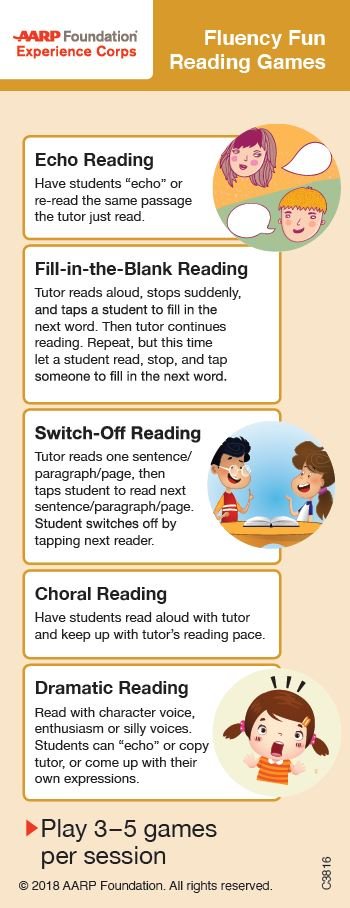Making Reading a Game
Following are Fluency Fun Reading Games you will use with students to maintain their interest in repeatedly practicing the day’s passages. Repetitive reading builds fluency and confidence. Each game counts as one repetition. Re-reading a short section at least three to five times in one session means playing three to five games during that session. If there is not enough time within the session structure to allow for a minimum of three repeated readings (i.e., three games), then reduce the number of pages in the short section for the student or group to read during the next session. This will allow more repetitions to be read, thus providing the student with the minimum number of repetitions and the needed practice.
Once students learn how to play each game, you can allow them to use the Fluency Fun Reading Games Bookmark to choose games as well as to lead the games.
Echo Reading provides the most support for students and is always the first game played.

Reading Games

- Start each new section of pages with this game.
- Have the students “echo” or re-read aloud the same passage you just read.
This can be done as a sentence or two at a time or as a paragraph at a time, depending on the students’ abilities. - Make sure you start with this game each time. This models good pacing and fluency for the student, so it should be read at a normal pace.

- In this game, you read the text and then suddenly stop at a random word, tap a student, and that student fills in the next word. You then continue and repeat the process.
- This is a good game for second and third readings and to help with challenging text.
- Repeat the game, with the student leading and tapping other students (or you) to fill in the word.
○ Remember: The one doing all the work is the one learning, so have the students take turns leading this game. - Have students follow along with the reader, using their bookmark and reading silently.
○ Set the expectation that students not taking their turn reading aloud must still following and read silently.

- Have students read aloud with you and keep up with your regular reading pace.
- This is a good game for practice to increase pace.
- This game can also be used to support struggling readers by allowing them to read with you at their pace.

- Determine the amount (chunk) of text to be read at a time: sentence/ paragraph/page. You will read one sentence/paragraph/page, then tap a student.
- The student reads the next sentence/paragraph/page and taps someone else. Continue through the pages for the day.
- As a last game, the student reads a large chunk for Independent Reading, allowing you to determine that student’s fluency level. You can adjust the number of pages read in the next session based on the student’s fluency.
- After students are familiar with the game, change up the chunked amount at random while playing (e.g., if you started switching off with one sentence, try two sentences).
- Have students follow along with the reader, using their bookmark and reading silently.
○ Set the expectation that students not taking their turn reading aloud must still follow and read silently.

- Apply character voices or silly voices to a game while reading the section.
- Read focus words or phrases “over-enthusiastically” or with a special voice.
- Students can “echo” or copy you, or they can come up with their own dramatic voices.
- Have students follow along with the reader, using their bookmark and reading silently.
○ Set the expectation that students not taking their turn reading aloud must still follow and read silently.



